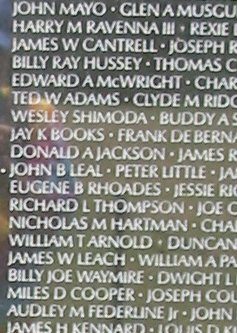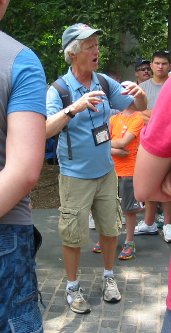The path leads around to the end of
the wall, where the first this I saw was a family gathered looking
somebody up in the directory.
As you walk from one end of the
wall to the other it starts out as a low marble wall. It's covered
with neat columns of names. At the end there is only one row of
names, but as you walk on it quickly turns into a wall that is
much taller than I, with more rows of names than I can count.
There is a solemn tone to the place.
I feel like that guy crouched with
family around was rubbing the name of an old friend that didn't
make it back. He looked like the kind of guy that would have gone
to serve just because his family has a tradition of service to the
USA. Probably did a good job to.
I followed the path around from the
end of the wall. There was a statue of three guys and a guy that
was obviously a tour guide explaining the history to people. He
said that the original wall had sparked a lot of controversy when
it was built. Some felt that it didn't honor the guys that made it
back at all, so the statue of the three men, one each from the big
three ethnic groups here (brown, white, and black) was added. Then
somebody else complained that there was no honor given to the
women that served and died there. Since most of them were nurses
they added the caregiver statue.
Then he explained that what is
really unique about this memorial is how it attracts stuff. Every
day the Park Service finds stuff left by the wall. Sometimes it's
military medals or old love letters. One time somebody left a
brand new Harley Davidson motorcycle with license plate HERO. They
found out later that part of the rolling thunder march was a group
that guarantees rides home for any member that needs it. Their
leader had told the Park Service that was "in case any of those
names needed it." No they didn't want it back. A veterans group is
raising money to build a museum to show some of that stuff to the
public.
That tour left the area. I wandered
some more and found this Park Service Ranger starting another tour
of the wall. He explained that the names were in chronological
order, but rather than start on the left and go to the right the
list starts in the middle and goes up to the end and then
continues from the other end back to the middle again. Since only
known dead are listed there, occasionally they have to add another
name as one of the unknown soldier's remains are identified. You
can tell such names because for a while they look whiter than the
rest. They put them in as space allows as close to the right place
as possible.
The Viet Nam war didn't start neatly
with a declaration the way some do. It was a miasma of conflicting
ideas about what was going on. At first it was just trainers going
over to offer the French help with training the Vietnamese. The
first of those to die were in 1959, so the wall started counting
there. Then the situation escalated steadily for more than a
decade.
The open warfare was clearly ended
in 1975 with the evacuation of Saigon, which many people remember
seeing footage of on the nightly news. However since then agent
orange and the land mines we left there have continued to kill
people. He told us about another memorial to those victims, but I
never got a chance to visit that.
















